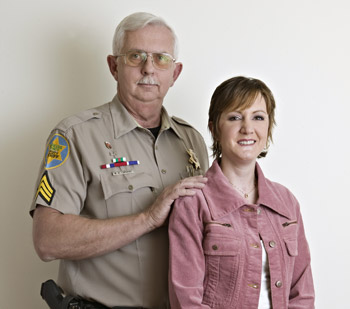
Maricopa County Sheriff Sgt. Wayne Lupinski was one of a team of professionals who helped save Erin’s life.
At first, her skull injuries, a small fracture and a scalp laceration, seemed to be the least of her problems, said neurosurgeon Paul LaPrade, MD. “It only took about 45 minutes to fix them.”
After surgery Erin woke and was responsive, but a few hours later went into a coma with “the largest epidural hematoma (bleeding between her skull and the tough outer lining of her brain) I’ve ever seen,” Dr. LaPrade said.
Worse, it was squeezing her brain stem, which controls breathing. “The brain stem does not like to be depressed,” Dr. LaPrade said. “Permanent damage can happen very quickly.”
Erin was rushed back to surgery, where Dr. LaPrade evacuated the hematoma. But another CT scan showed recurrent and residual brain bleeding, so Erin went for a third neurosurgery.
“We finally stopped the bleeding,” Dr. LaPrade said. “But I thought if she lived, she’d be in a vegetative state. I felt so depressed.”
Yet in the morning, Erin was awake, following commands. “I was surprised, amazed, thrilled,” he said, “so happy for her family. Erin is the only patient I’ve had with her level of brain injury whose recovery is so complete. It’s a miracle.”
It was five days before Erin was strong enough for Dr. Prichard to put her delicate and beautiful face back together.
This is tricky business – each side of the face is controlled by a network of five microscopic major nerves that branch and sub-branch up and outward from the jaw.
In addition, the bony structure of the right side of Erin’s face was “much worse than a gunshot,” observed Dr. Prichard. “I had to rebuild her eye socket, her cheekbone and her jaw, all of which were in multiple pieces.”
Then it was time for the hand surgeon. “The human hand is amazing,” Dr. Champagne mused. “It can be expressive, a conductor guiding an orchestra; powerful, a workman tossing a 100- pound sack of cement; delicate, performing microsurgery; or emotional, petting a dog. Its anatomy and neurophysiology is so complex; it is irreplaceable. ”
Dr. Champagne used all his skills, “but don’t call me a hero,” he said. “The real hero is Erin. She’s that one patient in a thousand who works so hard, goes above and beyond with rehab and therapy, she makes all her surgeons look good.”
Erin has had several more operations to maximize her recovery and spent time pondering her future.
“She worked as a hospital volunteer when she was a teen,” said Erin’s mom, Carol McCormick. “She liked helping people, and now she’s planning on nursing instead of law school.”
“I am so grateful to all the amazing people who helped me,” Erin said. “I can never adequately express how much I appreciate everything that was done for me.”
Visit JCL.com/trauma for more information.
